
Sambandar, also referred to as Tirujnana Sambandar, Tirujnanasambanda, Campantar or Jñāṉacampantar, was a Shaiva poet-saint of Tamil Nadu who lived sometime in the 7th century CE. He was a child prodigy who lived just 16 years. According to the Tamil Shaiva tradition, he composed an oeuvre of 16,000 hymns in complex meters, of which 383 (384) hymns with 4,181 stanzas have survived. These narrate an intense loving devotion (bhakti) to the Hindu god Shiva. The surviving compositions of Sambandar are preserved in the first three volumes of the Tirumurai, and provide a part of the philosophical foundation of Shaiva Siddhanta.
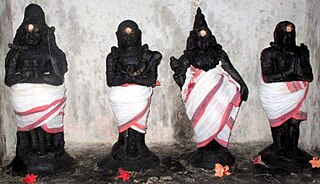
Thirumurai is a twelve-volume compendium of songs or hymns in praise of Shiva in the Tamil language from the 6th to the 11th century CE by various poets in Tamil Nadu. Nambiyandar Nambi compiled the first seven volumes by Appar, Sampandhar and Sundarar as Tevaram during the 12th century. During the course of time, a strong necessity was felt by scholars to compile Saiva literature to accommodate other works. Tiruvasakam and Tirukovayar by Manickavasagar are included as the eighth, nine parts are compiled as the ninth Tirumurai out of which most are unknown, and the tenth as Tirumandiram by Tirumular, the famous Siddhar. The eleventh is compiled by Karaikal Ammaiyar, Cheraman Perumal and others. The contemporary Chola king was impressed by the work of Nambi and included Nambi's work in the eleventh Tirumurai. Sekkizhar's Periya Puranam, composed a century later, contains the life depiction of all the 63 Nayanmars. The response for the work was so tremendous among Saiva scholars and Kulothunga Chola II that it was included as the 12th Tirumurai. Tirumurai along with Vedas and Saiva agamas form the basis of Saiva Siddantha philosophy in South India and Sri Lanka.

Rajaraja I born Arulmoli Varman often described as Rajaraja the Great was a Chola emperor who reigned from 985 CE to 1014 CE and was the most powerful king in south at his time chiefly remembered for reinstating the Chola power and ensuring its supremacy in South India and Indian Ocean.

The Nayanars were a group of 63 poet-saints living in Tamil Nadu during the 3rd to 8th centuries CE who were devoted to the Hindu god Shiva. Along with the Alwars, their contemporaries who were devoted to Vishnu, they influenced the Bhakti movement in early medieval South India. The names of the Nayanars were first compiled by Sundarar. The list was expanded by Nambiyandar Nambi during his compilation of material by the poets for the Tirumurai collection, and would include Sundarar himself and Sundarar's parents.
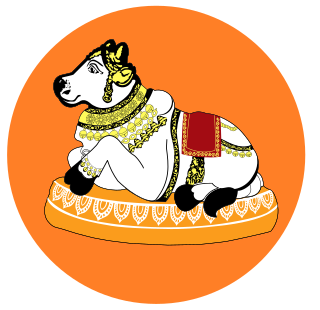
Thiruvasagam is a volume of Tamil hymns composed by the ninth century Shaivite bhakti poet Manikkavasagar. It contains 51 compositions and constitutes the eighth volume of the Tirumurai, the sacred anthology of the Tamil Shaiva Siddhanta.

The Periya purāṇam, that is, the great purana or epic, sometimes called Tiruttontarpuranam, is a Tamil poetic account depicting the lives of the sixty-three Nayanars, the canonical poets of Tamil Shaivism. It was compiled during the 12th century by Sekkizhar. It provides evidence of trade with West Asia The Periya Puranam is part of the corpus of Shaiva canonical works.
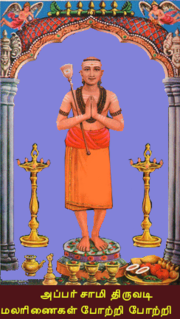
Appar, also referred to as Tirunāvukkarasar or Navukkarasar, was a seventh-century Tamil Śaiva poet-saint. Born in a peasant Śaiva family, raised as an orphan by his sister, he lived about 80 years and is generally placed sometime between 570 and 670 CE. Appar composed 4,900 devotional hymns to the god Shiva, out of which 313 have survived and are now canonized as the 4th to 6th volumes of Tirumurai. One of the most prominent of the sixty-three revered Nayanars, he was an older contemporary of Thirugnana Sambandar.
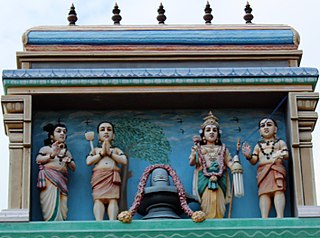
Sundarar, also referred to as Chuntarar, Chuntaramurtti, Nampi Aruran or Tampiran Tolan, was an eighth-century poet-saint of Tamil Shaiva Siddhanta tradition of Hinduism. He is among the Tevaram trio, and one of the most prominent Nayanars, the Shaiva bhakti (devotional) poets of Tamil Nadu.

The Thevaram, also spelled Tevaram, denotes the first seven volumes of the twelve-volume collection Tirumurai, a Śaiva narrative of epic and puranic heroes, as well as a hagiographic account of early Saiva saints set in devotional poetry. The Thevaram volumes contain the works of the three most prominent Saiva Tamil poets of the 7th and 8th centuries: Sambandar, Appar, and Sundarar. The three poets were not only involved in portraying their personal devotion to Shiva, but also engaged a community of believers through their songs. Their work is an important source for understanding the Śaiva Bhakti movement in the early medieval South India.

Thiruvathigai Veerateeswarar Temple is a Hindu temple dedicated to Shiva. It is situated in Thiruvathigai village which is about 2 kilometres east from the town of Panruti in the South Indian state of Tamil Nadu, India. Shiva is worshiped as Veerattaaneswarar, and is represented by the lingam. His consort Parvati is depicted as Thiripurasundari. The presiding deity is revered in the 7th century Tamil Saiva canonical work, the Tevaram, written by Tamil saint poets known as the nayanars and classified as Paadal Petra Sthalam. The temple is considered the place where the Saiva saint poet Appar (Thirunavukkarasar) converted back to Saivism, and attained final salvation.

Sattainathar temple, Sirkazhi is a Hindu temple dedicated to Shiva located in Sirkali, Tamil Nadu, India. The temple is incarnated by the hymns of Thevaram and is classified as Paadal Petra Sthalam. It is an ancient temple complex with three different Shiva shrines in three stories.

Aiyarappar is a Hindu temple dedicated to Shiva located in the village of Tiruvaiyaru, Tamil Nadu, India. The Five Rivers are Vadavaru, Vennaaru, Vettaaru, Kudamuruttiyaaru and Kaaviriyaaru. Shiva is worshiped as Aiyarappar, and is represented by the lingam and his consort Parvati is depicted as Dharmasamvardhini. The presiding deity is revered in the 7th century Tamil Saiva canonical work, the Tevaram, written by Tamil poet saints known as the nayanars and classified as Paadal Petra Sthalam.
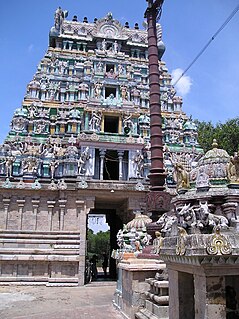
Kalyanasundaresar Temple, Nallur or Thirunallur is a Hindu temple dedicated to the deity Shiva, located in Nallur, in the outskirts of Kumbakonam in Tamil Nadu, India. Shiva is worshiped as Kalyansundaresar, and is represented by the lingam. His consort Parvati is depicted as Girisundari. The presiding deity is revered in the 7th century Tamil Saiva canonical work, the Tevaram, written by Tamil saint poets known as the nayanars and classified as Paadal Petra Sthalam. The legend of the temple is associated with sage Agastya and Amaraneethi Nayanar, one of the 63 nayanars, the Tamil Saiva saints. The lingam in the temple is believed to change colours five times during the day time.

Odhanavaneswarar Temple, Tiruchotruturai is a Hindu temple dedicated to Shiva located in the village of Tiruchotruthurai, Tamil Nadu, India. The Five Rivers are Vadavaru, Vennaaru, Vettaaru, Kudamuruttiyaaru and Kaaviriyaaru. Shiva is worshiped as Odhanavaneswarar, and is represented by the lingam and his consort Parvati is depicted as Annapoorani. The presiding deity is revered in the 7th century Tamil Saiva canonical work, the Tevaram, written by Tamil poet saints known as the nayanars and classified as Paadal Petra Sthalam.

Masilamaniswara Temple is a Hindu temple dedicated to Hindu god Shiva, located in the village Thiruvaduthurai, located 22 km from the South Indian town, Kumbakonam and 14 km from Mayiladuthurai, Tamil Nadu. It is one of the shrines of the 275 Paadal Petra Sthalams. The temple is referred to in the verses of Tevaram, the 7th century Tamil Saiva canon by Tirugnana Sambandar, Appar and Sundarar. The temple is associated with the legend of Saivite saint Tirumular.

Padikasu Nathar Temple is a Hindu temple located at Azhagaputhur, a village in the Thanjavur district of Tamil Nadu, India. Shiva is worshiped as Padikasunathar, and is represented by the lingam. His consort Parvati is depicted as Soundaranayagi. The presiding deity is revered in the 7th century Tamil Saiva canonical work, the Tevaram, written by Tamil saint poets known as the nayanars and classified as Paadal Petra Sthalam. The 8th century Saiva saint poet Sundarar has sung praise about the temple in his works.

Isaignaniyar, also spelt as Isainaniyar, Isaignaniyaar, Isaignaniar and Isaijnaniyar and also known as Isai-jnani Ammaiyar, is the mother of Sundarar, one of the most prominent Nayanar saints. She is herself regarded as a Nayanar saint, venerated in the Hindu sect of Shaivism, along with her husband Sadaiya Nayanar. She is generally counted as the last in the list of 63 Nayanars.

Tiru Nilakanta Yazhpanar was a Nayanar saint, venerated in the Hindu sect of Shaivism. He is generally counted as the sixty-first in the list of 63 Nayanars. While the first part of his name can be spelt as Tirunilakanta, Tirunilakantha, Tiru Neelakanta, Tiru Nilakanta, Nilakantan and Thiruneelakanda, Yazhpanar is spelt as variously as Yalppanar, Yalapannar, Yalpanar and Yazhpaanar. He is described as a companion of Sambandar, one of the most prominent Nayanars.

Natrunaiyappar Temple(நற்றுணையப்பர் ஆலயம்) is a Hindu temple dedicated to Shiva, located in the village of Ponsei or Thirunanipalli(Chola Nadu - South of Kaveri), Mayiladuthurai district, East-Central Tamil Nadu, South India. It's one of the holy place "Tevaram has been sung on the primary god of the Shiva ". From north side Chidambaram to The Mahendra Mountain totally 63 Shiva temples have been presented. It's also one of the part of 63 Shiva's holy places. Once upon a time Ponsei was ruled under Chola dynasty

Agnipureeswarar Temple in Thirupugalur, a village in Nagapattinam district in the South Indian state of Tamil Nadu, is dedicated to the Hindu god Shiva. Constructed in the Tamil style of architecture, the temple is believed to have been built during the Cholas period in the 10th century. Shiva is worshipped as Agnipureeswarar and his consort Parvathi as Karundar Kuzhali. The temple is believed to be the place where Saiva saint Appar is believed to have attained salvation.
















